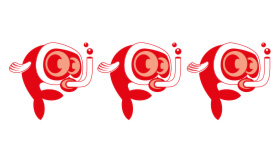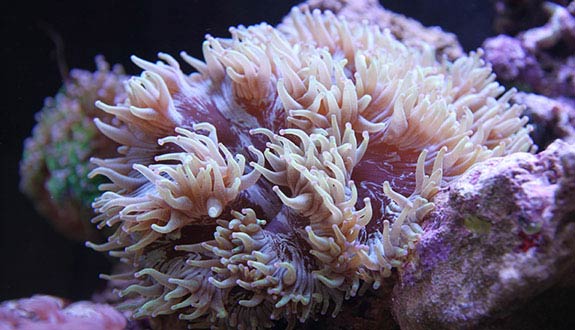

Alternative species (click on the thumbnail to see the card)
Names
Scientific name
Catalaphyllia jardinei
Common name
Elegance Coral
Elegant Coral
Wonder Coral
Origin

Origin: South Pacific and Indian Ocean
Kind

Kind: Hard Coral with long polyp (LPS)
Form: its general color varies from brown to fluo green. Generally, its tips are bright pink, blue, orange or violet
Group

Euphyllidae
Volume

200 L / 44 imp gal / 53 US gal
Parameters

T°: 23 to 28°C or 73 to 82°F
pH: 7.5 to 8.5
Density: 1021 to 1028
Difficulty

Hard
Size

30cm/12" long about 20cm/8" wide
Brewing

Low
Lighting

Average
Aggressiveness

Average (urticant)
Food
How to feed the Catalaphyllia?
Food
How to feed the Catalaphyllia?
This coral is home to microalgae called zooxanthellae and it feeds on it.
It is strongly advised to make contributions in Mysis, krill, plankton and artemia regularly, almost daily. For this, use a needle-less syringe and disperse the food into the coral. Maximum size of food: 6 mm or 0.24 inch.
It may be interesting to offer food as a whole (fish, mussels, shrimps). Indeed, different parts of the animal have different nutritional qualities, feeding your coral this way will give good results. Finely chop the food and offer it to your coral.
Cohabitation
Who can live with the Catalaphyllia?
Cohabitation
Who can live with the Catalaphyllia?
Like many stinging corals, observe a safety zone around Catalaphyllia jardinei to avoid burns (at least 15 cm or 5.9 inch).
This coral has little possibility of cohabitation: it is sensitive to algae and soft corals. Even with family members, cohabitation can be tricky. For example, Euphyllia ancora will surely dominate and damage Catalaphyllia jardinei.
On the fish side, note that the agitation of some fish, such as clownfish for example, can stress this coral and prevent it from developing. Conversely, it can be a good predator of small fish such as Mandarin Fish, which can succumb to a bite in a few days.
Breeding
How to breed the Catalaphyllia?
Breeding
How to breed the Catalaphyllia?
The breeding of this species is quite rare. Do not risk cutting your coral because it causes tissue damage that can cause illness. Under optimal maintenance conditions, it can form rejects at the base of the foot that you can then harvest.
Its aquarium
Which aquarium for the Catalaphyllia?
Its aquarium
Which aquarium for the Catalaphyllia?
Be sure to position your coral under a medium to strong light. A light brewing will also be appreciated. For example, the bottom or the sides of the aquarium will be indicated at its reception. Make sure your aquarium is mature enough before introducing this coral.
The ideal setting will consist of rocks and sand. Although it prefers flat rock supports, it can also be content with being on the sand.
Be careful near tentacles and living rocks: they can be abraded and cut. This can damage tissues and cause infection of the brown jelly.
Good To know
Find all additional information!
Good To know
Find all additional information!
Elegance Coral are generally easier to maintain and healthier.
Those with too light or translucent color no longer have zooxanthellae and will not survive for long.
If your coral spreads its tissues widely, it probably looks for more light. This may indicate poor lighting or that it is aging, or a bad location. This polyp expansion is not a good indication of growth, but rather a sign of distress. To be sure that your coral is growing well, measure its skeleton when it comes to your home, and start again 6 months later: only the growth of the skeleton indicates a healthy expansion.
This coral is susceptible to the brown jelly or protozoan infections and introduction into an immature aquarium.
Yours photos!
Comments
Sort by:
Please login to post comments

